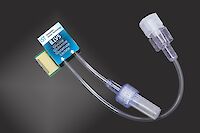 Innovative Sensor Technology IST AG combines thin-film and thick-film technology to manufacture physical, chemical and biological sensor elements. Their wide variety of sensors are important components for monitoring temperature, flow, humidity, conductivity, and biological metabolites.
Innovative Sensor Technology IST AG combines thin-film and thick-film technology to manufacture physical, chemical and biological sensor elements. Their wide variety of sensors are important components for monitoring temperature, flow, humidity, conductivity, and biological metabolites.
Medical care increasingly relies on technology-aided systems and smart medical devices. Biomedical sensors for example, can deliver data on specific metabolic, physical and chemical conditions. They are part of systems that process clinical samples, such as “lab-on-a-chip” devices. Biomedical sensors are also often used to monitor the safety of medicines, food, environmental conditions, and other substances.
These sensors combined with peristaltic microfluidic pumps and viral RNA extraction kits, complete the IST AG product portfolio for medical devices and enable the following specialist applications.
Detect critical diabetic conditions with biosensors
The analysis of metabolic markers such as glucose, lactate and pyruvate is becoming increasingly important in point-of-care and intensive care monitoring. Biosensors enable early warning before critical conditions regarding diabetes or sepsis can even occur. Various monitoring strategies on integration and sampling can be applied to biosensors, from continuous monitoring with short-term implants or invasive sampling (intensive care) to semi-continuous monitoring with minimally invasive sampling (e.g. subcutaneous fluid or sweat). Coupled with extracorporeal membrane blood treatment (oxygenation, dialysis) the biosensors can be combined with microfluidic, multiparametric analyzers. A unique long-term stability and a very compact, adaptable design make the biosensors from IST AG suitable for all integration options mentioned.
Peristaltic Micropumps
 Constructed for bi-directional microfluidic pumping IST AG’s micropump portfolio pumps liquids and gases between the range of 1 to 1700 μl/min. Its small footprint, longevity and excellent linearity across a wide pump rate range makes it ideal for all precision lab and testing applications.
Constructed for bi-directional microfluidic pumping IST AG’s micropump portfolio pumps liquids and gases between the range of 1 to 1700 μl/min. Its small footprint, longevity and excellent linearity across a wide pump rate range makes it ideal for all precision lab and testing applications.
With the addition of the CPP1-1000-ZM to the existing pump line-up applications with varying pump rates from single µl/min into the ml/min regime are now possible. In IST AGs CPP1 peristaltic pumps only the tubing is in contact with the medium, preventing contamination of the pumped liquids or gases. The media passes the pumps through a medical-grade silicone tube. The CPP1-1000-ZM shares the main features of the CPP1 line, such as 2 bar separation between the in- and outlet, tight flow control and a low power uptake.
Patient monitoring with temperature sensors
Platinum RTD elements are known for their long-term stability and simple signal processing. IST AG produces BondSens, the world’s smallest Pt-1000 element that can be integrated into microfluidic systems, disposable sensors, or implantable microelectronics for patient monitoring.
In addition to temperature measurement, platinum RTDs can also be used for precisely positioned and regulated heat generation as temperature-controlled point heating. These heat flow sensors are a special type of multi-layer temperature sensors, which are handled as core temperature measurement.
Breathing monitoring with flow sensors
 Flow sensors are essential to any breathing cycle monitoring or control device – including spirometry, ventilators, and inhalers.
Flow sensors are essential to any breathing cycle monitoring or control device – including spirometry, ventilators, and inhalers.
For the evaluation of the breathing cycle, sensors with an extremely fast response time (<5 msec.) and flow direction detection are required. The calorimetric elements MFS02 and SFS01 from IST AG are designed to deliver the required performance with a measurement resolution that enables new possibilities for signal evaluation, e.g. the flow volume of each breath cycle.
All flow sensors from IST AG feature thermal detection principles without moving parts involved in the sensor design. Their reliability, sensitivity and small footprint make them the logical choice for all gas supply applications in analysis devices.
With relatively simple electronics, a switch or control can be implemented on an FS7 sensor. If no flow channel has been defined, several flow sensors can be integrated and evaluated as a cluster or in a 3D grid.
Image 3 flow sensors
Conductivity sensors for monitoring extracorporeal blood purification
For monitoring membrane processes, in which ionic compounds dissolved in liquids are separated, electrical conductivity is a simple and robust solution for measuring indicative parameters.
Dialysis is such an ultrafiltration process that is used for extracorporeal blood purification and uses conductivity as a decisive control parameter. Conductivity sensors from IST AG achieve high-precision results with a platinum RTD on the same chip. A planar 4-electrode design with biocompatible materials makes the sensors ideal for a variety of applications in medical products and biotechnology where biofilm problems and clogging pose a risk.
About Innovative Sensor Technology IST AG
 Headquartered in Ebnat-Kappel, Switzerland, the IST AG is celebrating its 30th anniversary this year. The developer and manufacturer of sensor products has around 450 employees worldwide. Thanks to their experience with materials and adaptive production processes, the requirements of various applications, such as miniaturization, can be individually addressed – from extensive service when it comes to advanced application needs to the development of new technologies. www.ist-ag.com
Headquartered in Ebnat-Kappel, Switzerland, the IST AG is celebrating its 30th anniversary this year. The developer and manufacturer of sensor products has around 450 employees worldwide. Thanks to their experience with materials and adaptive production processes, the requirements of various applications, such as miniaturization, can be individually addressed – from extensive service when it comes to advanced application needs to the development of new technologies. www.ist-ag.com


